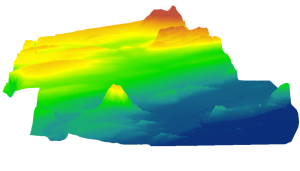

The terrain dataset references participating feature classes (source measures) that define how they contribute to the terrain and maintain the rules specifying how these source measures are used within the terrain dataset. Possible editing scenarios include workflows in which operators are restricted to editing data layers within constrained areas or workflows in which operators are responsible for edits to individual layers for unconstrained areas such as all lidar data. If the design is realized, the edits can be posted back to the source data. What-if scenarios can be modeled by allowing design edits that model proposed changes to be made without actually changing the original surface. In ArcSDE, versioned terrain datasets support multiple users accessing different representations of the terrain for different projects. Personal geodatabases are the least desirable for terrain datasets, and their use should be restricted to terrains with fewer than 20 million points. File geodatabases can be used for terrains with billions of points but do not allow multiuser editing. An ArcSDE geodatabase is the most capable format and is appropriate for terrains involving billions of points and workflows that use a centralized database to manage source measures and terrain datasets in a multiuser editing and versioning environment. While terrain datasets are supported in all ArcGIS geodatabase formats, it is important to note that these formats have inherent differences in capacities. Consequently, the data management advantages of the geodatabase are available to terrain datasets. Terrain datasets and the data used to define them are stored and maintained in a feature dataset in a geodatabase. The terrain dataset supports point, multipoint, polyline, and polygon-based features and is seamless, fast, and scalable.īecause source measurements are stored, not a derivative surface, they can be edited and replaced with more current or accurate data at anytime. This is achieved through the use of an updated and efficient TIN-based data structure that generates a multiresolution surface that is created on the fly for a given area of interest and level of detail. These surface storage and representation methods are not well suited to large collections of mass point data from sources such as lidar, photogrammetric, and multibeam sonar data.Īn ArcGIS terrain dataset offers a database-oriented solution for managing these vector-based source measurements. Traditionally, ArcGIS uses feature data, like 3D points, lines, and contours, to make TINs and grids. Terrain datasets scale to handle vector-based source measurement data such as lidar, photogrammetric, and sonar data.


Using the TIN, any surface value can be interpolated within a face or along an edge.Īdditional rules are defined to generate TIN pyramids representing elevation change. The nodes of each triangle have an x,y coordinate and a z-value representing the elevation or surface value at that location.
How to get digital terrain model series#
TINs are assembled from a series of data points with x-, y-, and z-values and partition geographic space into contiguous, nonoverlapping triangles (called faces). This multiresolution, triangulated irregular network (TIN)-based surface is generated using measurements stored as features in geodatabase feature classes. With ArcGIS 9.2, Esri introduced the terrain dataset to better handle surface data. It generally includes a series of points representing the high and low extremes in the terrain that define topographic features such as streams, levees, ridges, and other phenomena. Terrain data is usually expressed as a series or collection of points with x-, y-, and associated z-values. Terrain datasets, which live inside geodatabases, offer many advantages for managing surface data.


 0 kommentar(er)
0 kommentar(er)
